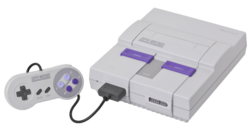Super Nintendo Entertainment System
| Super Nintendo Entertainment System | |
|---|---|
 | |
 Den amerikanske udgave af SNES  Den japanske udgave af SNES | |
| Fabrikant | Nintendo |
| Type | Videospilkonsol |
| Generation | 4. generation (16-bit era) |
| Først udgivet | |
| CPU | 16-bit 65c816 Ricoh 5A22 3.58 MHz |
| Lyd | Nintendo S-SMP |
| Medier | Game Pak |
| Onlinetjeneste | Satellaview (kun Japan), XBAND |
| Solgte enheder | 49,10 millioner[1] |
| Mest solgte spil | Super Mario World, 20 millioner[2] |
| Forgænger | Nintendo Entertainment System |
| Efterfølger | Nintendo 64 |
Super Nintendo Entertainment System, også kendt som Super Nintendo, Super NES eller SNES, er en 16-bit videospilkonsol udgivet af Nintendo i Nordamerika, Brasilien, Europa og Australien i 1991. I Japan, hvor den er kendt som Super Famicom, produceredes den siden 1990. I Sydkorea er den kendt som Super Comboy. Sidstnævnte konsol licenseredes og distribueredes af Hyundai Electronics.
Super Nintendoen var som efterfølger til Nintendo Entertainment System, og derfor Nintendos anden hjemmekonsol. Mens den første ikke vandt stor popularitet i Europa og store dele af Asian, blev SNES en global succes, på trods af at den, grundet forøget konkurrence fra Segas Mega Drive-konsol (udgivet i Nordamerika under navnet Genesis), ikke blev så populær som sin forgænger i hverken Sydøstasien eller Nordamerika. Trods dens relativt sene udgivelse i forhold til tidens teknologiske standarder, blev SNES den mest solgte konsol i 16-bit-æraen, men først efter at konkurrenten Sega flyttede sit fokus til 32-bit-markedet.
Referencer
- ^ "IR Information : Sales Data - Hardware and Software Sales Units". Nintendo Co., Ltd. Hentet 3. juli 2017.
- ^ Edge (25. juni 2007). "1990". The Nintendo Years. Next-Gen.biz. s. 2. Hentet 28. oktober 2007.
| ||||||||||||||||||||||||||||||||||||||||
| ||||||||||
| Spire Denne spillekonsolsrelaterede artikel er en spire som bør udbygges. Du er velkommen til at hjælpe Wikipedia ved at udvide den. |
|
Medier brugt på denne side
The Flag of Europe is the flag and emblem of the European Union (EU) and Council of Europe (CoE). It consists of a circle of 12 golden (yellow) stars on a blue background. It was created in 1955 by the CoE and adopted by the EU, then the European Communities, in the 1980s.
The CoE and EU are distinct in membership and nature. The CoE is a 47-member international organisation dealing with human rights and rule of law, while the EU is a quasi-federal union of 27 states focused on economic integration and political cooperation. Today, the flag is mostly associated with the latter.
It was the intention of the CoE that the flag should come to represent Europe as a whole, and since its adoption the membership of the CoE covers nearly the entire continent. This is why the EU adopted the same flag. The flag has been used to represent Europe in sporting events and as a pro-democracy banner outside the Union.Forfatter/Opretter: unknown, Licens: LGPL
Game pad icon (imitating the Gravis Gamepad except its screw-hole in the d-pad)
Forfatter/Opretter: Evan-Amos, Licens: CC BY-SA 3.0
A Super Nintendo Entertainment System (SNES or Super NES) video game console, shown with standard controller.
Super Nintendo Entertainment System logo. All trademark rights are held by Nintendo of America Inc.
A Super Nintendo Entertainment System (SNES or Super NES) video game console, shown with standard controller.
The Super Famicom, a video game console released by Nintendo in 1990. The 16-bit follow up to the successful Famicom, and it became the highest selling console of its generation, selling close to 50 million systems worldwide. Worldwide, the system was known as the Super Famicom, and in the North American markets it received a boxier, purple redesign.











